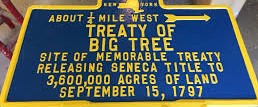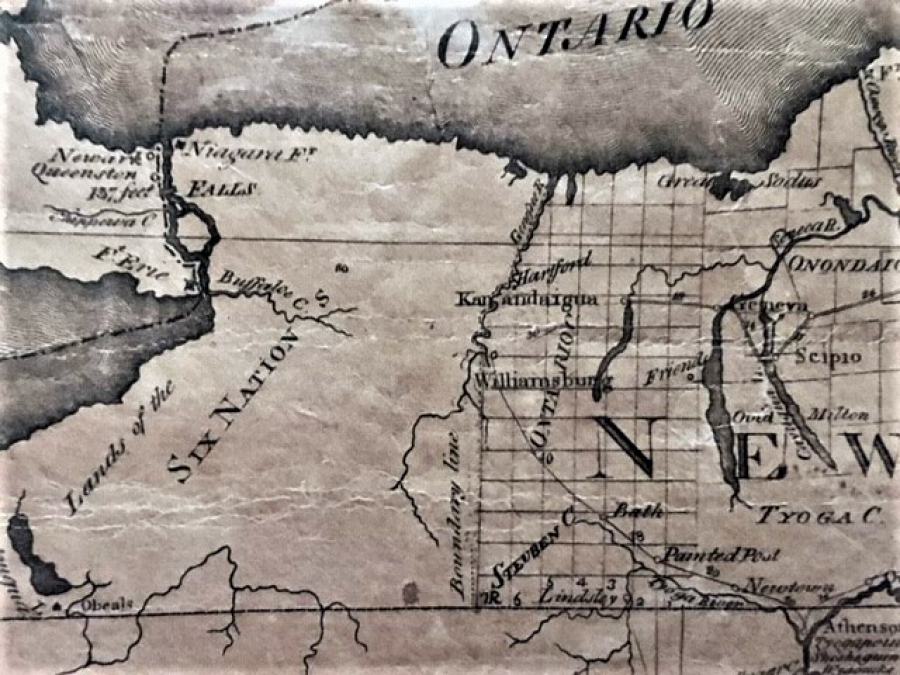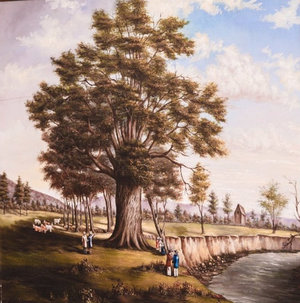Today it is called western New York but before 1800 everything west of the Genesee River (that runs north and south through Rochester) was primarily inhabited by Indians, wild animals, and fur traders, and known as the land of Six Nations.
This is the area where Lorette’s family settled as early as 1802, but possibly the first white man to settle in this area was said to be Cornelius Winney, a fur trader from the Fishkill area of the Hudson Valley in New York. He ran a trading store on Buffalo Creek, present-day approximate location of Key Bank Center in downtown Buffalo. In 1792 a man named, Hinds Chamberlin wrote regarding his travels through the area, “We arrived at the mouth of Buffalo Creek the next morning. There was but one white man, I think; his name was Winney, an Indian trader. His building stood first as you descend from the high ground.” Hinds goes on to say that Winney traded liquor with the Indians for their knives and tomahawks. By 1798 Cornelius left the vicinity (never to be heard of again) supposedly having said that the area was getting “too crowded.”
How right he was.
The following year several wealthy Dutchmen became the owners of this vast tract of land which became known as the Holland Land Purchase. It included all the land as far east as the Genesee River, as far north as Lake Ontario, as far west to the Canadian border, and as far south to the Pennsylvania state line. Back then it was all known as Genesee County, New York, but today this area encompasses the counties of: Niagara, Erie, Chautauqua, Orleans, Genesee, Wyoming, Cattaraugus, and Allegany.
In 1802 Lorette’s great grandfather, Peter Powers, and his brother Blanchard Powers came to Batavia to purchase land in the Town of Batavia. They were offered generous terms set up by Joseph Ellicott and could move their large families here where there was plenty of land to farm and build homes. Seven of Peter’s eleven children, Asahel, Webster, Polly, Mehitable, Sarah, Nancy, and Roxanny lived here on land purchased from the Holland Land Office. People like them became known as the Pioneers of Genesee County.
Big Tree - A Native American meeting place located next to the Genesee River, in what is known today as Geneseo, New York. The tree, estimated to be 1500 years old, fell in 1857 during a flood of the Genesee River, which flows into Lake Ontario. A section of the tree can be seen in the Livingston County Historical Society building in Geneseo.
And what about the Native Americans that lived there?
In 1797, Robert Morris, an interim owner before the Holland Land Purchase, met with a council of Indians at the Treaty of Big Tree, and obtained interests of all their land except eleven "reservations" set aside solely for Indian use. These became known as the Reservations of the Tuscarora (east of Lewiston), the Tonawanda (both sides of the Tonawanda Creek), the Buffalo (both sides of the Buffalo Creek), the Cattaraugus (each side of that creek on Lake Erie), the Allegany (both sides of the Alleghany River), the Oil Spring (between Allegany and Cattaraugus counties), the Canandea (along the Genesee River), the Gardeau (near Mt. Morris), the Squakie Hill (north of Mt. Morris), the Little Beard's and Big Tree (near Geneseo), and the Canawaugus (west of Avon).
That was then; many changes have taken place since, not necessarily good for our Native American inhabitants. It has since been reported by some, that the Treaty may have been illegal - as in 1790, Congress prohibited States from negotiating with Indian Nations for the purpose of acquiring land.


